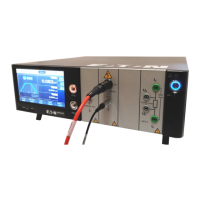User manual SEFELEC 5x Series 193 v1.06
therefore it is possible to destroy or burn the specimen under test. The power of the HV source
being limited, continued use of the OFF detection mode can trigger the built-in thermal safety
switch. Under those circumstances (display of the message: INTERLOCK DISABLE) wait be-
tween 3 and 5 minutes before proceeding to the tests.
Ground continuity measurement
On a unit or an electrical device using or generating hazardous voltages, ground continuity
measurements ensure that all the accessible protective parts are correctly connected to the pro-
tective ground connection wire.
This measurement is almost a low resistance measurement except that it has to be performed
with a high current, mostly in AC.
The principle is to flow a current between each metallic accessible parts and the protective
ground connection, to measure the voltage drop between the 2 parts and to check with the
Ohm’s law that the equivalent resistance is lower than the standard required value.
19.6.1. Current selection
The measurement current is defined by the safety standards which have to be used for each
product. According to the main standards, this high current is comprised between 10 and 25 A
AC or equal to 2 times the nominal operating current of the device.
The choice is justified by the fact that the protective ground connections have to be able to flow
the fault current for the maximum value of the unit operating current and this during the reaction
time of the other protective devices (fuses, breakers, etc...)
19.6.2. Voltage selection
This is the open voltage of the current generator used for the measurement. This voltage,
mostly given by each safety standards is mandatory a low value (lower than the threshold de-
fining a hazardous voltage) but it must allow the measurement current flowing, taking care of
the voltage drops between the generator and the measurement points.
The open voltages are comprised between 6 and 12 AC volts.

